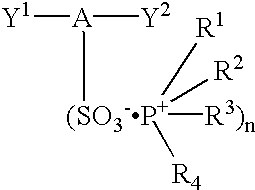These resins have poor adhesion to PET, thereby causing
delamination, whereby a container loses its transparency, and a laminate consisting of different types of polymers is disadvantageous from the viewpoint of
recovery.
Both methods involve such problems that satisfactory gas barrier properties are not achieved, a reduction in
glass transition temperature (Tg) is large and
heat resistance deteriorates.
However, the gas barrier properties of EVOH and PA greatly depend upon
humidity and deteriorate at a
high humidity.
PVDC may generate a poisonous gas such as dioxin when it is burnt.
However, as these films have high tear strength, when they are used in a wrapping bag and their contents are to be taken out from the wrapping bag, the bag cannot be easily ripped open and it takes time to take out the contents.
These methods boost costs, disadvantageously.
When the
intrinsic viscosity is lower than 0.4, the formed film has poor strength disadvantageously.
As for the relationship between the degree of orientation and gas barrier properties, the gap between molecular chains becomes smaller as the molecular chains are oriented by stretching rather than in a random state, thereby making it more difficult to transmit gases.
When
crystallinity is too high, gas barrier properties improve but tenacity is lost when a
polymer is formed into a film or the like, disadvantageously as practical use.
When the total of Young's moduli is below the above range, the strength of the film becomes insufficient when in use.
When the total of breaking strengths is below that range, the strength of the film becomes insufficient when in use.
When the
plane orientation coefficient is smaller than 0.02, the strength of the film becomes insufficient disadvantageously.
When the ratio is smaller than 4, tear strength becomes too high as compared with piercing strength, thereby making it difficult to obtain sufficient piercing resistance and tearability.
As the value of
moisture permeability increases, water-
vapor barrier properties lower, thereby making it difficult to use it to pack contents which are apt to be easily damaged by
water vapor, such as
dried food.
When the breaking elongation retention is smaller than 50% and the film is exposed to the
sunlight for a long time, the film readily becomes defective.
When the
ultraviolet transmission is more than 40% and the film is used to pack food, the film may modify contents disadvantageously.
When the average particle
diameter is smaller than 0.05 .mu.m, it is difficult to provide sufficient slipperiness and when the average particle
diameter is larger than 5.0 .mu.m, the surface of the film tends to become uneven.
Otherwise, dispersibility becomes unsatisfactory.
A film having a thickness of more than 400 .mu.m after stretching is not preferred for such production reasons that it is difficult to stretch the film because it is too thick and heat hardly reaches the inside of the film when it is heat set.
When 2,6-naphthalenedicarboxylic acid is used alone and the amount of 2,6-naphthalenedicarboxylic acid is smaller than 40 mol %, the anti-block properties of the obtained film lower disadvantageously.
When the amount is larger than 90 mol % and the polyester is to be dispersed in water to prepare a
coating, the
dissolution of the polyester in a hydrophilic
organic solvent becomes difficult, thereby making it difficult to disperse it in water.
However, when the amount of 2,6-naphthalenedicarboxylic acid is 100 mol %, even if glycol components are copolymerized, the obtained polyester does not dissolve in a hydrophilic
organic solvent any longer.
The
copolymer which does not satisfy the above conditions is unsatisfactory in terms of adhesion and anti-block properties.
When the amount of the aromatic
dicarboxylic acid (SD) having a
sulfonate salt group is 0 mol %, the hydrophilic nature of the obtained
copolymer lowers, thereby making it difficult to disperse it in water.
When the amount is larger than 5 mol %, the anti-block properties of the obtained film lower disadvantageously.
When the total amount of
ethylene glycol (EG) and tetramethylene glycol (TMG) is smaller than 40 mol %, the adhesion and anti-block properties of the obtained film lower disadvantageously.
When the total of Young's moduli is below the above range, the strength of the obtained film becomes insufficient disadvantageously.
When the amount of
titanium is larger than 300 ppm, the obtained polyester becomes yellowish and deteriorates in
heat resistance disadvantageously.
When the amount of
germanium contained in the polyester is smaller than 30 ppm, sufficient
polymerization activity cannot be obtained and it may be difficult to produce the polyester.
When the amount of
germanium contained in the polyester is larger than 400 ppm, the color of the obtained polyester may worsen or the
heat resistance thereof may lower.
When the number of foreign substances of 10 .mu.m or more in size is larger than 50 and, for example, a biaxially oriented film is formed from the aromatic polyester containing these foreign substances, portions around the foreign substances are stretched, thereby forming voids around the foreign substances with a
high probability of producing large film surface defects.
Therefore, when it is used as a packing film, its color becomes worse and cuts down consumers' purchase desire.
When the
intrinsic viscosity is lower than 0.4, the obtained film is unsatisfactory in terms of mechanical properties and when the
intrinsic viscosity is higher than 1.5, moldability stretchability becomes insufficient disadvantageously.
When a
metal other than those is used, the obtained anti-
fungus agent deteriorates in
antifungal properties and environmental
pollution disadvantageously.
0.01, sufficient
antifungal properties cannot be obtained and when the proportion of A.sub.1 is 0.5 or more, it foams disadvantageously at the time of adding it to the
polyester resin.
When the total
haze is smaller than 0.1%, the film loses appropriate friction and workability, thereby reducing productivity.
 Login to View More
Login to View More 


